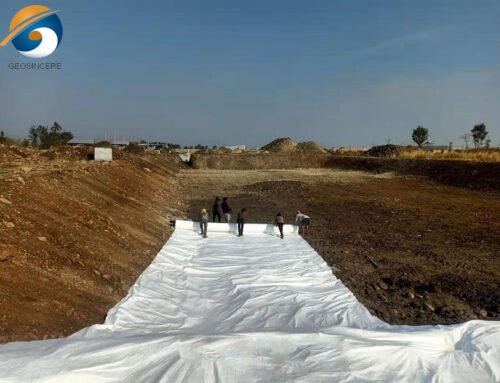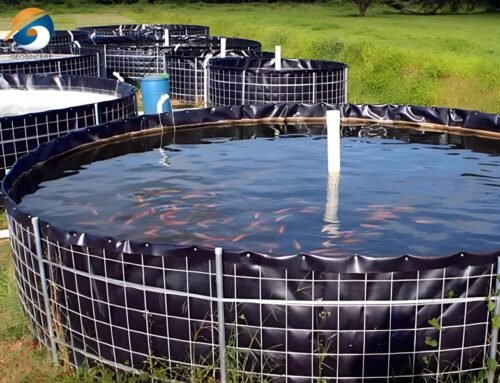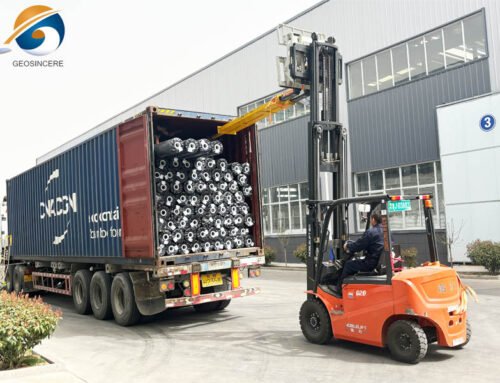LLDPE vs HDPE pond liner, which one is better for waste containment projects? Choosing the right pond liner material is crucial for antiseepage projects. Both LLDPE and HDPE liners are popular choices. Understanding their differences helps in making an informed decision. This article explores the key aspects of LLDPE vs HDPE pond liners, aiding in selecting the optimal liner for specific waste containment needs.
GEOSINCERE Geosynthetics is specilizes in high quality geomembrane pond liner manufacturing and supplying for a wide variety of challenging waste containment applications. A flexible pond liner is a durable material for lining ponds and water features. Unlike rigid materials like concrete or fiberglass, flexible liners are made from EPDM, PVC, or HDPE. These liners conform to the shape of the pond, creating a watertight seal. They come in various thicknesses, from 0.5mm to 3.0mm, with thicker options for commercial use. Their flexibility helps resist damage and punctures. HDPE liners are popular for their chemical and UV resistance.
1. What Are Similarities Between LLDPE Pond Liner and HDPE Pond Liner
1.1 Same Raw Material
Both LLDPE and HDPE pond liners are crafted from polyethylene. This material is prized for its versatility and resistance to many chemicals. Polyethylene finds use across multiple sectors because it’s strong, flexible, and offers other advantages. In the realm of pond liners, LLDPE and HDPE shine. They endure water exposure, sunlight, and various environmental elements.
1.2 Good Processing Property
LLDPE and HDPE pond liner are low-cost polymers known for their good processing properties. These polymers can be easily molded, extruded, or formed into various shapes and sizes, making them highly versatile in manufacturing processes. Their affordability and ease of processing contribute to their widespread use in a wide range of applications across industries.
1.3 Low Permeability
LLDPE and HDPE pond liners are synthetic membranes with very low permeability. They greatly reduce liquid or gas transmission. This minimizes water leakage and seepage. The liners create effective watertight barriers for ponds, reservoirs, and containment applications.


1.4 Better Chemical Resistance Property
Both HDPE Pond Liner and LLDPE Pond Liner exhibit comparable chemical resistance properties. They both have good tolerance to alcohols, dilute bases and acids. However, they have limited resistance to aliphatic and aromatic hydrocarbons, mineral oils, oxidizing agents and halogenated hydrocarbons.
It’s important to consider the specific chemical environment of the pond when selecting a pond liner material to ensure that the liner will provide adequate protection against chemical exposure.
1.5 Excellent Electrical Insulation Property
Both LLDPE pond liner and HDPE pond liner have excellent electrical insulation properties. This means that they can effectively prevent or reduce the flow of electric current, making them ideal for use in applications where electrical conductivity is a concern. For this properties need to be produced to be conductive geomembrane liner. Most cases, in waste containment industry as landfills, conductive geomembranes can be used where the dissipation of static charges is important for safety and to avoid the risk of spark generation in the presence of flammable gases. And it need to test the leaking point and avoid contamination for the environment.
1.6 Low Temperature Resistance Property
Both LLDPE pond liner and HDPE pond liner exhibit excellent resistance to low temperatures. They can endure cold environments without becoming brittle or developing cracks. This quality is crucial for pond liners installed outdoors, as they may face extreme temperature variations. By retaining their integrity in cold conditions, these liners ensure their long-term durability and effectiveness in maintaining the pond’s containment.
2 What is Difference of LLDPE vs HDPE Pond Liner
2.1 Different Density of LLDPE vs HDPE Pond Liner
Density is the most important difference their name implies. The density of a material is an important physical property that can affect its behavior in various applications. In the case of pond liners, the density can impact factors such as the liner’s strength, flexibility, and resistance to punctures or tears.
The density of HDPE pond liner is in the range of 0.93 to 0.97 g/cm3. In contrast, the density of LLDPE pond liner falls within the range of 0.910 to 0.920 g/cm3. This indicates that LLDPE pond liner has a less dense material than HDPE.
2.2 Different Melting Point of LLDPE vs HDPE Pond Liner
HDPE has a melting point of 135°C. This means that when the temperature reaches this range, the HDPE material softens and transitions from a solid to a liquid state.
On the other hand, LLDPE has a melting point of 122°C. When the temperature rises within this range, the LLDPE material undergoes a similar transition, becoming molten and losing its solid form.
It’s important to note that these melting point ranges indicate the temperatures at which the respective pond liners start to melt, but the specific melting point can vary depending on factors such as the grade and composition of the material.


2.3 Different Tensile Strength
HDPE pond liner has a tensile strength between 20 and 40MPa, and LLDPE pond liner is 10-25MP. The specific value is also related to the thickness. Compared with LLDPE pond liner, HDPE pond liner has higher tensile strength.
Tensile strength refers to the maximum amount of tensile stress a material can withstand before breaking or deforming. HDPE has higher tensile strength which makes it more resistant to stretching and pulling forces, which can be advantageous in applications where strength and durability are important factors. LDPE, on the other hand, is known for its flexibility and ease of processing.
2.4 Different UV Resistance Property
HDPE pond liner offers excellent resistance to UV (ultraviolet) radiation compared to LLDPE pond liner. This property helps to prolong the lifespan of the pond liner and maintain its integrity even when exposed to sunlight. UV radiation can cause degradation and damage to certain materials over time, including some types of plastics. The superior UV resistance of HDPE pond liner makes it a popular choice for applications where prolonged exposure to sunlight is expected, such as outdoor ponds or reservoirs. LDPE, while still resistant to UV radiation, is generally less effective at withstanding long-term exposure to sunlight compared to HDPE.
2.5 Different Transparency
LLDPE pond liner is generally more transparent compared to high density polyethylene pond liner. LLDPE has a lower density and a more amorphous structure, which allows for greater light transmission and transparency. This transparency can be beneficial in certain applications where visibility or aesthetics are important, such as decorative ponds or aquaculture systems. HDPE, on the other hand, is typically more opaque or translucent due to its higher density and crystalline structure.
2.6 Different Flexibility
LLDPE pond liner is typically more flexible when compared to HDPE pond liner. LLDPE has a lower density, which grants it increased flexibility and pliability. This flexibility enables LLDPE pond liners to conform to the pond’s shape more easily, making them a popular option for diverse water containment needs. On the other hand, HDPE is more rigid and less flexible, making it better suited for specific industrial or heavy-duty applications that prioritize strength and durability.
3 Conclusion
HDPE pond liner has higher density, higher melting point, higher tensile strength, better UV resistance than LLDPE pond liner, it is suitable for uneven and tough applications such as large ponds for mining, road construction, industrial, reservoir dam, garbage disposal, salt production, large farm project, and more.
LLDPE pond liner is more flexible and transparent compared to HDPE pond liner. It is suitable for landscape lake, home courtyard pond, fish or shrimp farming, swimming pool and small water amusement park, and more.
Finally, HDPE pond liner is generally more preferred than LLDPE (Liner Low-Density Polyethylene) pond liner for it enhanced resistance against tearing, punctures, and UV radiation. Additionally, HDPE requires more specialized equipment and complex manufacturing processes..
As the professional geomembrane HDPE liner manufacturer, we recommend HDPE pond liner as the lining material for your waste containment projects.
If you have any questions or requirements for pond liner in waste containment project, please contact GEOSINCERE team. Our team is 24 hours online to provide the best services for you.





